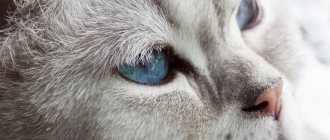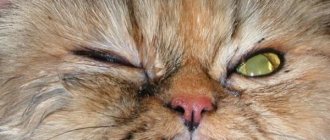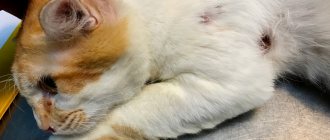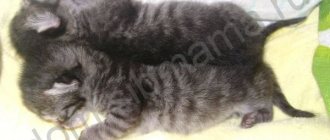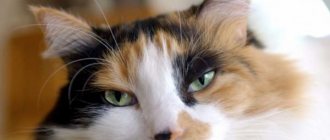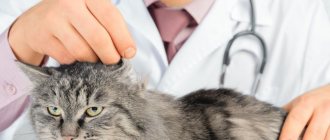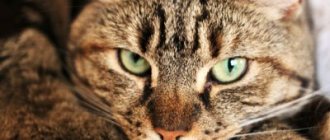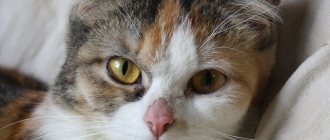An animal's nasal discharge is an attempt by its body to get rid of a pathogen or allergen. Often, secretion from the nose is accompanied by sneezing, impaired nasal breathing, and the cat may open its mouth slightly to breathe. The animal often licks its nose and the area around it. The fur near the nose becomes damp. Nasal secretions may contain blood.
It must be remembered that nasal discharge in cats cannot be ignored and the situation cannot be left to chance. For a cat, the nose is an organ with which he analyzes the world around him. Without a keen sense of smell, it’s difficult even for a domestic cat.
Causes
Pus from the nose
Diseases in which pus is discharged from the nose are divided into contagious and non-contagious.
The following are considered contagious:
- Herpes (rinotracheitis);
- Calicivirus;
- Cat flu;
Among the diseases of non-contagious etiology, the following most often develop:
- chronic diseases and colds;
- foreign bodies;
- congenital anomalies;
- tumors.
The causes of diseases, clinical symptoms, methods of diagnosis, treatment and prevention are not the same. Let's consider each disease separately.
Herpes (rhinotracheitis)
Herpes
The disease occurs among unvaccinated cats when kept in crowded conditions, unbalanced feeding in nurseries or shelters. Sick kittens die 10-14 days after the first signs appear. Those who have recovered become a reservoir of infection. There is a high probability of transplacental infection. The owner brings the virus into the apartment.
In addition to nasal discharge and cough, stomatitis, conjunctivitis with subsequent ulceration of the cornea, and mouth breathing develop. Constipation occurs and pregnant women abort. In the chronic course of the disease, panophthalmitis develops and the cat goes blind. An accurate diagnosis is established in the clinic.
The treatment is developed by a veterinarian. Prevention consists of timely vaccination, bringing living conditions and feeding into compliance with standards. If a cat refuses to eat for a long time, it is fed through a nasoesophageal tube. If signs of dehydration are detected, droppers with plasma substitutes are placed.
Nasoesophageal tube
When the cat begins to feed on its own, the veterinarian prescribes wet canned food or soaked granules.
Be sure to read:
One of the cat's eyes is watering: reasons, what to do at home, medications and folk methods
Calicivirus
Ulcerative glossitis with calcivirosis.
In terms of symptoms, etiology, and pathogenesis, the viral disease resembles Herpes. A cough occurs and bronchopneumonia develops.
Distinctive features are ulcerative stomatitis and the absence of ulcerations on the cornea. Lameness appears suddenly, but disappears spontaneously after a few days. The treatment strategy and prevention are the same as for Herpes.
Cat flu
Polyvalent vaccine
Often Herpes and Calicivirus affect a pet at the same time. The disease was called cat flu. When making a diagnosis, attention is paid to the presence of signs of both diseases. A complex vaccine against calicivirus, rhinotracheitis and panleukopenia reliably protects against infection.
Cat flu is not dangerous to humans.
Symptoms of a cat's nasal infection
Symptoms and the intensity of its manifestation depend on the age, condition, activity of the immune system, level of resistance, and conditions of keeping the animal.
In addition to nasal suppuration, the following symptoms are noted:
- frequent attacks of wet cough;
- shortness of breath, difficulty breathing;
- wheezing, wheezing when breathing;
- decreased activity, lethargy, apathy, depression;
- change in behavior;
- temperature increase by 1-2 degrees;
- pain on palpation of the nose;
- fever, chills;
- refusal to eat;
- weight loss;
- dull, faded coat;
- photophobia.
In addition to purulent discharge in cats, a pathological secretion of a mucous, catarrhal nature is also released from the eyes.
Any pathological symptoms require an urgent visit to the veterinary clinic. Thick purulent secretion makes breathing difficult and increases the inflammatory process. In addition, in some cases, nasal suppuration is one of the symptoms of infections that require urgent treatment. After examination and tests, the veterinarian will prescribe effective therapy.
Chronic diseases and colds
Rhinitis occurs as a symptom of exacerbation of the following permanent diseases:
- diabetes;
- urolithiasis disease;
- renal pathologies.
Too frequent bathing leads to hypothermia and reflex swelling of the mucous membrane. Ventilating rooms freshens the air, however, cats cannot tolerate drafts and become hypothermic. In hot weather, you should not leave your pet in a room with air conditioning running, otherwise he will catch a cold.
If the disease is caused by hypothermia, and the pet’s health is satisfactory, use dual-use drops - Maxidin or Anandin. Drugs intended for humans should not be used without the approval of a veterinarian.
What to do if your cat's nose is festering
As a rule, a complex treatment of the cat is carried out, aimed at normalizing the respiratory function and general condition of the animal.
The following is used in treatment:
- antibacterial, antiparasitic agents in injections, tablets, drops;
- antifungal drugs;
- immunomodulators;
- homeopathy remedies;
- physiotherapeutic procedures;
- alternative medicine.
Congenital anomalies
Spontaneous selection leads to the birth of offspring predisposed to rhinitis. Sometimes kittens are born with a deviated nasal septum.
Hypothermia or a reaction to odors leads to reflex swelling of the mucous membrane and rhinitis. Atopic dermatitis occurs in predisposed cats over one year of age. This is a reaction to dust, smoke and odors. Along with a runny nose, cats develop cough, conjunctivitis, and skin diseases.
Be sure to read:
A cat eats poorly: normal or pathological, reasons, first aid, what to do, how to get it to eat
Congenital anomalies are incurable. However, with a successfully developed therapeutic strategy, exacerbations can be stopped.
A cat's nose is festering: the main reasons
Nasal suppuration is caused by increased activity of pyogenic pathogenic microflora. This is the main reason for the appearance of profuse purulent nasal discharge.
Causes of nasal suppuration in cats:
- viral, bacterial, parasitic infections;
- mycoses (fungal diseases);
- respiratory diseases (otitis, rhinitis, rhinotracheitis, inflammation of the eustachian tube);
- purulent, catarrhal conjunctivitis;
- trauma, mechanical damage to the nasal cavity;
- presence of foreign objects in the nose;
- inflammatory processes, infection of the mucous membrane;
- chronic allergies (food, non-food);
- decreased resistance, immune defense;
- congenital defects of the upper respiratory tract;
- dental diseases;
- pathological neoplasms in the nasal cavity and other parts of the respiratory tract;
- nasopharyngeal, nasal polyps;
- unsuccessful operations on ENT organs;
- exhaustion, weakening of the body.
Abundant gray-green cloudy purulent discharge from the nasal cavity of a cat, accompanied by wheezing, coughing, sneezing, indicates the development of serious diseases (panleukopenia, leukemia, peritonitis). Nasal suppuration is noted with calcivirosis, chlamydia, herpes virus infection, severe helminthic infestation, rhinotracheitis, toxoplasmosis, viral pneumonia, strepto-staphylococcal infection.
Important! The risk group includes small kittens, weakened animals, street animals, cats kept in groups in unfavorable conditions, and unvaccinated individuals.
A cat’s nose can also fester if there are wounds on the lobe, the lesions in which pathogenic flora has entered, causing acute, chronic inflammation.
Symptomatic diet and procedures
To make it easier for an animal to breathe before going to the hospital, its nasal passages must be cleared of crusts. This can be done using cotton wool and baby oil. You can soak the crusts using saline or boric acid (2% solution can be purchased at the pharmacy). The animal may resist when you help it, so you should wrap it in a blanket and hold it under your arm, or use the help of another family member.
Wet cleaning of the room and humidification of the air will help make nasal breathing easier for your animal; you can take your cat with you to the bathroom. While you take a shower or bathe, the cat will breathe moist air.
If the animal refuses to eat because it does not smell the aroma of the food, the food can be heated a little to enhance the aroma or poured with liquid from canned tuna to stimulate the animal's appetite.
It is important to provide the animal with constant access to clean water at room temperature.
In order for an ailment such as nasal discharge to occur to the animal as rarely as possible, it is important to carry out measures to generally strengthen the body. This is first of all:
- Adding active dietary supplements and vitamins to the diet.
- High-quality balanced nutrition.
- The use of general strengthening drugs, such as gamavit, immunofan, fosprenil, ibotan. Your veterinarian will help you calculate the dosage of medications.
You shouldn’t treat even the most harmless rhinitis in your pet. Frequent complications of untreated rhinitis are otitis (with subsequent complete loss of hearing), deformation of the muzzle, sinusitis, penetration of infectious agents into the brain (this condition threatens the life of the animal).
Take care of your pets, treat their illnesses on time!
Discharge from the eyes.
Transparent or brownish tears, occasionally and a little - this is natural.
By the way, brown liquid happens due to mixing feed from different manufacturers or artificial with natural ones. Adjust your diet and wash your pet's eyes with chamomile decoction.
But excessive tearfulness (and redness of the eyes) indicates that the outflow of tears is impaired, foreign objects have entered, or a disease has begun.
Suppuration of the eyeball, swelling and redness of the eyelids, the animal squints, cannot open its eyes - is associated either with a serious infection (conjunctivitis, for example), or due to a foreign body located there, or damage during a fight. On the same day - consultation and treatment, and in case of self-medication, you will miss precious time.
